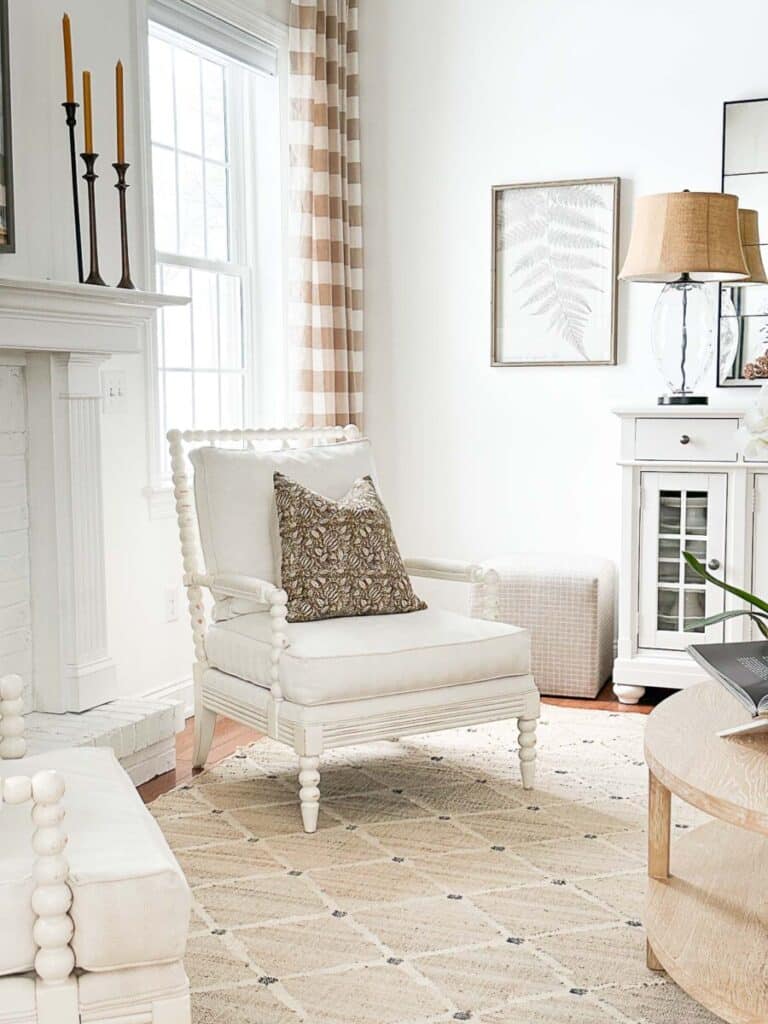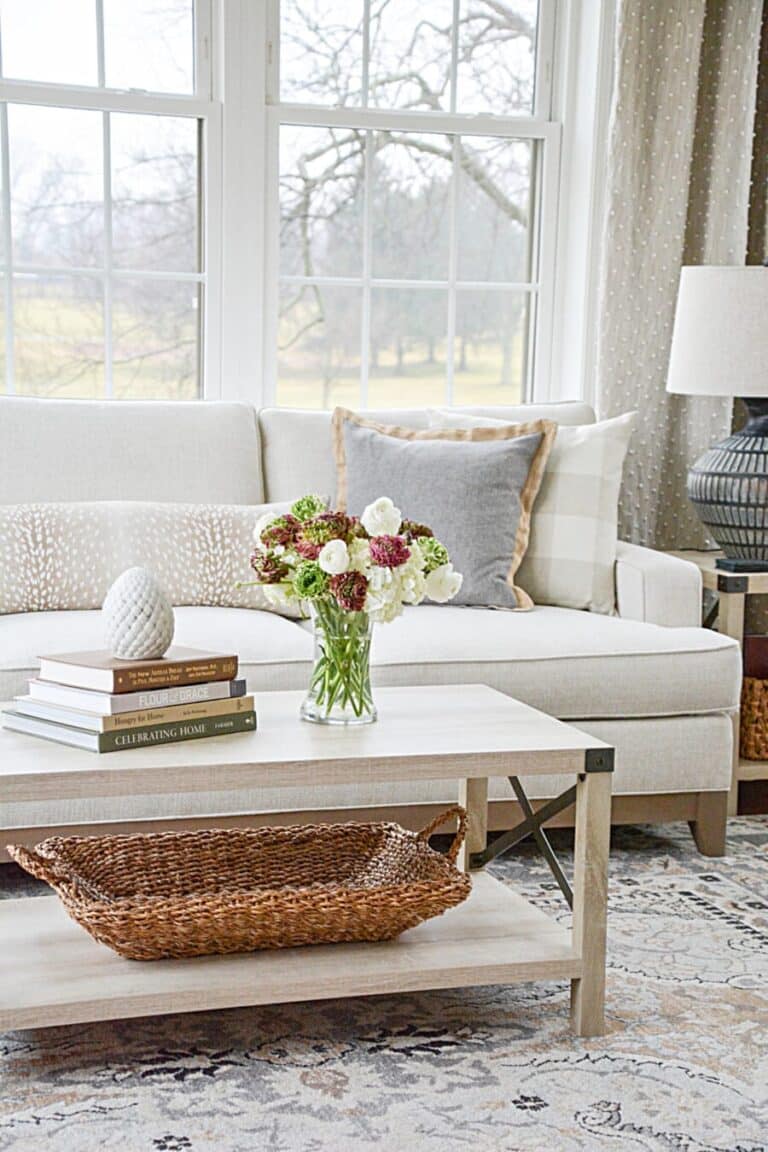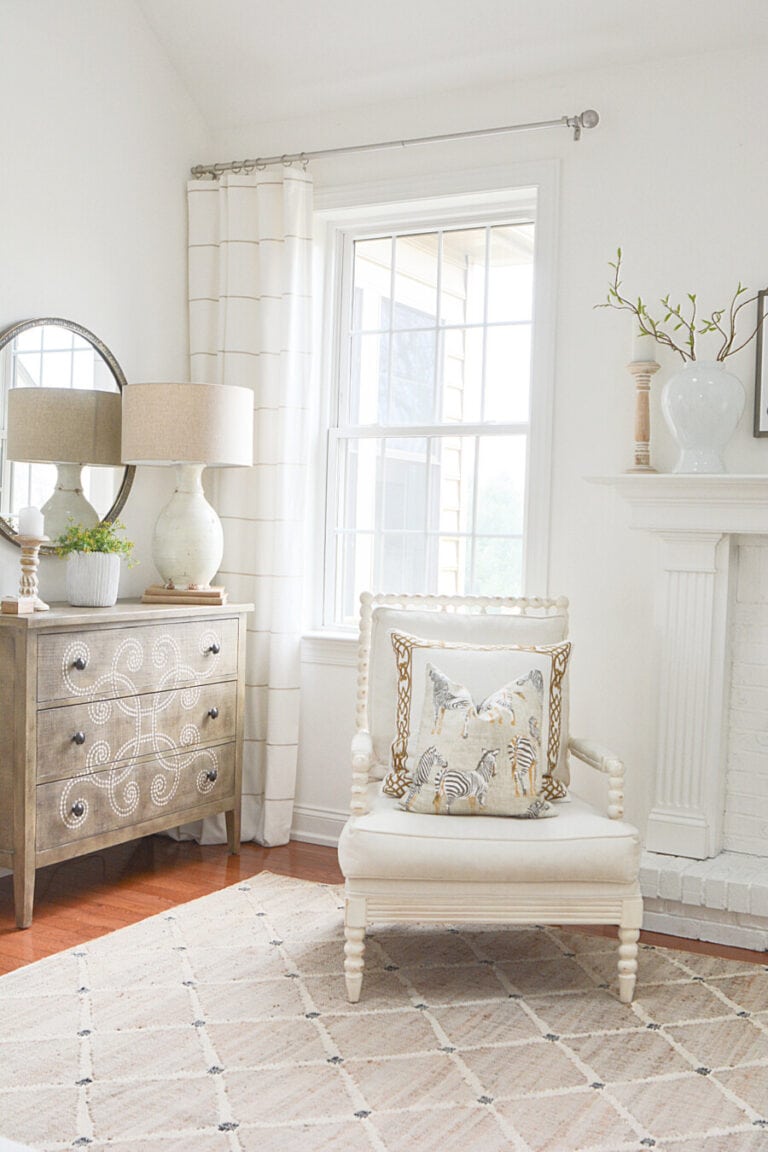Scale And Proportion: Your Key To Better And Easier Decorating
Decorating is so much easier if you understand the important principles of interior design. Here’s an easy, demystified look at Scale and Proportion in decorating. You can be a better and more confident home decorator!
When it comes to creating a beautiful room, it’s less about the price tag and more about how the elements in the space interact and play nicely together. It’s true. Understanding and applying the principles of scale, balance, and proportion can transform any room. You might think diving into interior design principles is boring or difficult. Are you in for a big surprise? It’s not hard, and if you put these principles into action in your home, you will instantly see the results.
Ready to explore and add the principles of SCALE AND PROPORTION to your decorating toolbelt? Great, They are simple, repeatable techniques that will elevate your home decor.
This post may contain affiliate links. See our Discloser Policy.
Welcome To Decorating School
Decorating School is a free resource for the everyday home decorator who wants to create a comfortable, beautiful home that meets the needs of their unique family. Every decorating post is filled with tried-and-true interior design tips and advice, broken down into easy, repeatable, and actionable steps.
What Is Scale
SCALE refers to how an item fits a space.
Here are a few examples of scale…
- Place a large sectional sofa in a spacious, open-concept living room.
- Use a small bistro table in a cozy breakfast nook.
- Choose a round 60-inch dining table for a medium-sized square dining room.
- Opt for a king-size bed in a generously sized master bedroom.
- Place a compact loveseat in a small apartment living area.
- Use an oversized armchair in a large reading corner.
- Choose a long, narrow console table for a wide hallway.
- Place a tall, slender bookcase in a small home office.
- Use a wide coffee table in front of a large sofa.
- Opt for a big, deep bathtub in a spacious bathroom.
This is super, super simplified, but it is a good working definition for us!
What Is Proportion
PROPORTION is how different objects relate to one another in a room.
Here are some examples of proportion…
- Pair a large sofa with equally substantial armchairs to maintain visual balance.
- Place a tall floor lamp beside a high-back chair for complementary height.
- Hang a series of small artworks together to create a balanced gallery wall.
- Use a large coffee table with a big sectional sofa to ensure scale compatibility.
- Match the height of bedside tables to the height of the bed for visual harmony.
- Choose table lamps that are proportionate to the size of the side tables.
- Place a wide mirror above a wide console table for balanced proportions.
- Use large throw pillows on a big sofa to keep the proportions consistent.
- Pair a tall headboard with high ceilings to complement the room’s height.
- Place a sizable centerpiece on a large dining table to maintain scale and proportion.
Again, it’s super overly simple, but it works!
Why You Should Use Scale And Proportion Interchangeably
Since we’re not professional interior designers, it’s not that important for us to differentiate between scale and proportion. What’s important is understanding how they work together to create beauty and harmony. For our purposes, we’ll treat scale and proportion as the same concept, even though they are distinct in design.
Easy To See Examples
Have you ever seen a clown car in a circus? What happens when the doors of this tiny car are opened? Tons of clowns pile out. It’s funny because there is something wrong with so clowns getting out of a tiny car! The car is the wrong sale or proportion to the clowns and vice versa.
Now, imagine a grand piano in a tiny studio apartment! It’s the same concept, but not so funny! The apartment does not fit together unless the piano is the only thing in it.
Home decorators should always consider how objects look together. Do the sizes and visual space they take up in a room make sense with everything else in the room?
A Mathematical Formula To Know
Scale and proportion are really driven by math. There is something called the GOLDEN RATIO worth knowing about. It shows up in nature over and over again, and it is exquisitely beautiful to our eyes and minds!
The ratio is 1:618. Now, that probably does not mean much to you, but if you saw this ratio in an object, you would definitely notice it. Things like faces, seed heads of flowers, shells, spiral galaxies, hurricane images and more all have this 1:618 ratio.
And we find great beauty in things close to this magical ratio!
For just a short minute, we need to talk about math. And you thought we were talking about decorating. Interestingly, a large part of decorating is related to math.
Mathematics basically influences scale and proportion. One key principle is the Golden Ratio. This ratio, often symbolized by the Greek letter phi (φ), is approximately 1:1.618 and appears repeatedly in nature, creating forms that are universally recognized as beautiful.
This ratio appears in many natural phenomena and structures, such as faces, flower seed heads, shells, spiral galaxies, and even hurricane patterns. When objects follow this ratio, they universally appear more harmonious and aesthetically pleasing to our eyes.
We naturally find great beauty in things that conform to this magical ratio. By incorporating principles of the Golden Ratio into our decorating, we can create spaces that feel balanced, cohesive, and visually appealing.
Luckily, all we need to know is that this ratio exists! With a bit of practice, we can become quite good at recognizing it. We already have a fabulous pair of tools for this purpose: our eyes!
Most of us have an inborn sense of beauty, scale, and proportion. Even if you think you can’t decorate, you likely have a built-in intuition for these concepts. Our natural ability to perceive and appreciate the Golden Ratio helps us create proportional and visually pleasing spaces.
Combine this innate sense with a bit of common sense, and you can effectively use your understanding of scale and proportion in your decorating efforts. This is great news for all home decorators, as it means you don’t need to be a professional to create beautiful, balanced spaces.
Practical Tips For Almost Perfect Scale And Proportion When You Decorate
Here are some very savvy, useful tips for incorporating scale and proportion when decorating a room.
LET YOUR EYES BE YOUR GUIDE
If an item in a room in your home looks off, out of place, funny, awful, or any other negative adjective, then it is. If it looks gorgeous, it is! If you can’t tell, keep reading the tips.
A Lesson From Goldilocks
Here’s a lesson from a famous girl with a great sense of decorating style…
A Lesson From Goldilocks
Goldilocks was looking for a chair and bed that were not too big and not too small, but just right! You should be looking for furnishings that are just right for a room and just right in relation to other things in the room. That should be your BIG GOAL!
Large furniture generally fits best in spacious rooms, while small, delicate furniture is more suited for smaller spaces. This makes sense, right?
Additionally, big, heavy furniture should not be mixed with slim, petite pieces in the same room, as the contrast can disrupt the room’s balance and harmony. Similarly, delicate furniture can look out of place next to bulky items.
It’s that simple.
Numbers Don’t Lie
Don’t guess the size of that chair you’re placing in your bedroom—know its measurements and then measure the space in your room. This simple step can save you countless headaches!
There’s an old carpenter’s adage, measure twice, cut once.
As a decorator, I say:
Measure correctly because the numbers don’t lie!
If you measure a piece of furniture properly, trust the numbers. If the measurements indicate it’s too big, believe it! If the numbers suggest it’s too small, trust that, too. Don’t buy anything just because you love it—everything must fit comfortably in your space. It must also be the right size to work well with the other furniture in the room.
One of the biggest mistakes home decorators make is buying items they love without considering anything else. It might look perfect in the store or online, but that doesn’t mean it will be perfect in your home.
Know how it will fit into a room and how it will look in relation to your other furnishings. I cannot stress this enough!
Negative Space
No one likes to be crowded in an elevator. It feels awkward, right? We love our personal space. Well, furnishings don’t like to be crowded either! They need their own personal space, too!
Negative space in interior design is the empty space around and between furniture and decor. It allows a room to breathe, making it feel open and uncluttered. Negative space highlights the beauty of the items in the room by giving them room to stand out.
Many home decorators make the mistake of putting too much stuff in a room—a double entendre, for sure! You can get the scale and proportion right, but if there are too many items in a room, it will feel cluttered and confusing.
Try removing accents and furnishings from a room until it feels spacious. You’ll be amazed at the difference!
Even empty space needs to be scaled to the room and the other furnishings in it. Ensuring that there is enough negative space can transform a room from feeling cramped and chaotic to open and inviting. Negative space allows the eye to rest and helps highlight the beauty of the items you do choose to display. So, when decorating, remember that sometimes less is more!
Using Patterns And Colors
Scale and proportion extend beyond furnishings and apply to using patterns and color in a room as well.
Here’s an easy rule of thumb to remember:
- Patterns: Bigger patterns look best in large rooms, while smaller patterns suit smaller rooms, with the exception of pillows. Large patterns can overwhelm a small space, making it feel cluttered, while small patterns in a big room can get lost and fail to make an impact. Choose patterns that complement the size of the room to create a harmonious look.
- Color: The larger the room, the more colors you can use effectively. In a spacious room, multiple colors can coexist without making the space feel chaotic. Conversely, in a smaller room, it’s best to limit the color palette. Using too many colors in a confined space can make it feel busy and overwhelming. Stick to a few complementary colors to keep the room feeling cohesive and balanced.
When using patterns and colors, always consider the room’s size and how these elements will interact with the space and each other. Using these simple, smart tips will make your room feel well-designed and visually appealing, no matter its size.
Where Science Meets Art
Just like almost everything we talk about when it comes to decorating, it’s part science and part art!
Knowing the basics of great interior design, like The Magic Rule Of Three and the golden ratio, will help you achieve a very attractive overall look. A bit of color theory and learning about concepts like balance will also help. These are all based on science and math!
However, your personality, personal preferences, and style will be the artistic touch that makes every room in your home feel and look unique.
There is no beauty without a synergistic mix of science and art!
Now you know why scale and proportion in decorating are so so important!
So, get acquainted with the elements of design and practice them in your home while pursuing a curated style all your own! This is the sweet spot of decor and the way to create a home that is truly comfortable, beautiful, and looks like you!
My Home Sources
FAQs About Scale And Proportion
Decorating School, Part 1
Learn easy, and doable interior design principles to use over and over again in your home to create beautiful and curated spaces.
Happy Decorating, Friends!
























Hey Yvonne! I just wanted to tell you how much I appreciate all the decorating/craft/shopping tips you share. I have been struggling with my living room for awhile but with your help I think I finally got it right! Your house is the house I would LOVE to have, it’s so beautiful. I do have a question though, I have a taupe sofa with white walls…can I put tans in that room without making it look “off”. Hope you know what I mean. Thanks for everything.
I adore taupe. Why not find pillows that have both tan and taupe in them. I think it is a nice way to add a bit of warmth to a cool color. Hope this helps.
Love your tips and neutral, textured home. Do you only use 4 chairs for your dining table or are there another 2 chairs that can be added? Are the ends of the table usable? Admiring your set!
Hi Carol, I only have 4 upholstered chairs that stay with my table all the time. When we have company we bring up other dining chairs that work with the upholstered ones from the basement. Hope this help.
It does help! There are just 2 of us empty nesters and a large dining room table w 6 chairs is really too much for day to day. I like considering an option of just 4 chairs like you have…with a leaf and additional chairs as needed. Thank you.
This article about proportion in a room/rooms has been one of the most helpful articles I have ever read. Definitely will follow this advice. Thanks Yvonne!
I wish every home decorator would read this. I really think it would help.
I would love to get a rug like yours please advise me where Imight find one please.
LOVE this new series!!! Thank you!!! Im learning so much
You are welcome.
I love your drapes. Would you mind sharing where you got them?
Hi Judy, they are from Ballard Designs. You can find them online.
Hi Yvonne,
This is such a helpful article! I live in a townhouse and my living room is dominated by a baby grand piano. No place else to put it and I struggle with furniture placement around it. Any ideas? You have given me such great ideas with other articles!
I’m disappointed you didn’t give any examples of how to use the golden ratio – those of us with more of a maths bent than an “eye” or natural talent really appreciate hard and fast rules to follow. I was excited when you said that maths was an essential part of decorating – “woohoo, this is something I can do!” But then you didn’t tell us how to apply it. I hope you can do a post on how to use the golden ratio and other maths based rules. I do love your home, it’s my ideal, so classic and sophisticated, but also cosy, friendly and relaxed. The only way I could achieve a space like that is to copy you slavishly, haha. Please, give us some rules with numbers in them, for those that don’t have an “eye” for decorating, but do have a tape measure.😂
Thanks, Karen. I appreciate your comment. I did talk about the golden ratio. You must have missed it. Here’s just a little excerpt:Mathematics basically influences scale and proportion. One key principle is the Golden Ratio. This ratio, often symbolized by the Greek letter phi (φ), is approximately 1:1.618 and appears repeatedly in nature, creating forms that are universally recognized as beautiful.
This ratio appears in many natural phenomena and structures, such as faces, flower seed heads, shells, spiral galaxies, and even hurricane patterns. When objects follow this ratio, they universally appear more harmonious and aesthetically pleasing to our eyes.